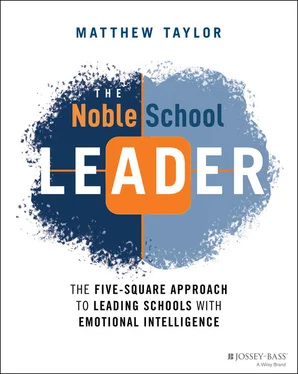1 Cover
2 Title Page The Noble School Leader The Five-Square Approach to Leading Schools with Emotional Intelligence Matthew Taylor
3 Copyright
4 Introduction
5 Acknowledgments
6 About the Author
7 I: Preparing to Do Mindset Work 1 Seven Invisible Obstacles to Strong School Leadership Why These Mindsets Matter We Cannot Teach Mindsets … … But Productive Mindsets Can Be Learned … And EI Is the Key Endnotes 2 Building New Mindsets and Behaviors with Emotional Intelligence Applying EI with the 5‐Square How the 5‐Square Works: A Personal Case Study The Left Side of the 5‐Square: Doing Our Self‐Work Building Self‐Awareness (What's My Stuff?) Building Self‐Management: Leveraging Our Standard, Managing Our Stuff, and Plugging into Our Drivers The Right Side of the 5‐Square: A Focus on Others Social Awareness: Where Are They and Where Do They Need to Be? Relationship Management: What Others Need from Me to Reach My Targets Applying the Five Domains to Grow Endnotes 3 Preparing for the Learning Journey by Connecting to Your Power Our Power Map Core Driver 1: Life Path Activity 1: Lifeline Activity 2: Values Sort Activity 3: Connecting to Values in Context Core Driver 2: Well‐Being Activity 1: Wellness Audit Activity 2: My Ideal Wellness Schedule Core Driver 3: Relationships Activity: Relationship Mapping Core Driver Four: Self‐Expression Self‐Expression and Flow Activity 1: Finding More Flow Self‐Expression and Personal Voice Activity 2: Where and How Am I Bringing My Voice? From Plan to Practice Endnotes
8 II: Working the 5-Square 4 The Transactional Leader Transactional Leadership and Its Costs in Learning Organizations Step 1: Start with the End in Mind Step 2: Building Self‐Awareness Connect with Your Power to Choose New Ways of Being Step 3: Building Self‐Management Strategies Self‐Work: Pause and Reflect Step 4: Build Social Awareness to Diagnose Needs and Set Targets Where Do They Need to Be? (Defining Your Targets) Step 5: Manage Relationships to Meet Your Targets Other Work: Pause and Reflect Now the Real Work Begins Endnotes 5 The Unintended Enabler Unintended Enabling in Learning Organizations Step 1: Start with the End in Mind Step 2: Building Self‐Awareness Step 3: Build Self‐Management Strategies Self‐Work: Pause and Reflect Step 4: Build Social Awareness to Diagnose Needs and Set Targets Where Do They Need to Be? (Defining Your Targets) Step 5: Manage Relationships to Meet Your Targets Other Work: Pause and Reflect Now the Real Work Begins Endnotes 6 The Negative Controller Negative Controllers in Learning Organizations Step 1: Start with the End in Mind Step 2: Build Self‐Awareness Step 3: Build Self‐Management Strategies Self‐Work: Pause and Reflect Step 4: Build Social Awareness to Diagnose Needs and Set Targets Where Do They Need to Be? (Defining Your Targets) Step 5: Manage Relationships to Meet Your Targets Other Work: Pause and Reflect Now the Real Work Begins Endnotes 7 The Pacesetter This Is Not Just About You Pacesetting, the Sacrifice Syndrome, and Schools Step 1: Start with the End in Mind Step 2: Build Self‐Awareness Step 3: Build Self‐Management Strategies Self‐Work: Pause and Reflect Step 4: Build Social Awareness to Diagnose Needs and Set Targets Defining Your Targets (Where You Need Them to Be) Step 5: Manage Relationships to Meet Your Targets Other Work: Pause and Reflect Now the Real Work Begins Endnotes 8 The Doer Doers in Education Organizations Step 1: Start with the End in Mind Step 2: Build Self‐Awareness Step 3: Build Self‐Management Strategies Self‐Work: Pause and Reflect Step 4: Build Social Awareness to Diagnose Needs and Set Targets Where Do They Need to Be? (Defining Your Targets) Step 5: Manage Relationships to Meet Your Targets Other Work: Pause and Reflect Now the Real Work Begins Endnotes 9 The Imposter Imposter Phenomenon in Education Organizations Step 1: Start with the End in Mind Step 2: Build Self‐Awareness Step 3: Build Self‐Management Strategies Self‐Work: Pause and Reflect Step 4: Build Social Awareness to Diagnose Needs and Set Targets Where Do They Need to Be? (Defining Your Targets) Step 5: Manage Relationships to Meet Your Targets Other Work: Pause and Reflect Now the Real Work Begins Endnotes 10 The Implementer Implementers in Education Organizations Step 1: Start with the End in Mind Step 2: Build Self‐Awareness Step 3: Build Self‐Management Strategies Self‐Work: Pause and Reflect Step 4: Build Social Awareness to Diagnose Needs and Set Targets Where Do They Need to Be? (Defining Your Targets) Step 5: Manage Relationships to Meet Your Targets Other Work: Pause and Reflect Now the Real Work Begins Endnotes
9 III: Staying Focused Over Time 11 Working Your 5‐Square for Lasting Behavior Change Build Your System
10 Appendices Introduction
11 Appendix A: Transactional Leader Sample 5‐Square Development PlanAspirational Leadership Headline Vision for Success
12 Appendix B: Unintended Enabler 5‐Square Development PlanAspirational Leadership Headline Vision for Success
13 Appendix C: Negative Controller Sample 5‐Square Development PlanAspirational Vision
14 Appendix D: Pacesetter Sample 5‐Square Development PlanAspirational Leadership Headline Vision for Success
15 Appendix E: Doer Sample 5‐Square Development PlanAspirational Leadership Headline Vision for Success
16 Appendix F: Imposter Sample 5‐Square Development PlanAspirational Leadership Headline Vision for Success
17 Appendix G: The Implementer Sample 5‐Square Development PlanAspirational Leadership Headline Vision for Success
18 Index
19 End User License Agreement
1 Chapter 3Table 3.1: Sample thought catcher.Table 3.2: Sample thought catcher for journaling.Table 3.3: Sample wellness schedule.Table 3.4: Flow audit.
2 Chapter 4Table 4.1: Sample targets.
3 Chapter 5Table 5.1: Sample targets.
4 Chapter 6Table 6.1: Sample targets.
5 Chapter 7Table 7.1: A systems analysis for organizational change.
6 Chapter 8Table 8.1: Sample targets.
7 Chapter 9Table 9.1: Sample targets.
8 Chapter 10Table 10.1: Sample targets.
1 Chapter 1 Figure 1.1: Goleman's competency iceberg. Figure 1.2: Wheatley's graphic illustration of the Green Line concept.
2 Chapter 2 Figure 2.1: Goleman's model. From GS‐4 Paper. (2015). A Self Study History (... Figure 2.2: The Noble Story Group's basic 5‐Square. Figure 2.3: The motivational spheres from Goleman EI (2019). Figure 2.4: The self‐limiting mindset chain reaction.
3 Chapter 3Figure 3.1: Motivational spheres.Figure 3.2: The rudder.Figure 3.3: Sample relationship map.Figure 3.4: Flow model diagram.Figure 3.5: Sample self‐expression Venn diagram.
4 Chapter 4Figure 4.1: The EI 5‐Square.Figure 4.2: Wheatly's Six‐Circle Model.
5 Chapter 5Figure 5.1: The EI 5‐Square.Figure 5.2: Wheatly's Six‐Circle Model.
6 Chapter 6Figure 6.1: The EI 5‐Square.Figure 6.2: Wheatly's Six‐Circle Model.
7 Chapter 7Figure 7.1: The EI 5‐Square.Figure 7.2: The Sacrifice‐Renewal Cycle.Figure 7.3: Common pacesetter competing commitments.Figure 7.4: Wheatly's six‐circle model.
8 Chapter 8Figure 8.1: The EI 5‐Square.Figure 8.2: Wheatly's Six‐Circle Model.
9 Chapter 9Figure 9.1: The EI 5‐Square.Figure 9.2: Wheatly's Six‐Circle Model.
10 Chapter 10Figure 10.1: The EI 5‐Square.Figure 10.2: Wheatly’s Six‐Circle Model.Figure 10.3: The rudder.
1 Cover Page
2 Title Page The Noble School Leader The Five-Square Approach to Leading Schools with Emotional Intelligence Matthew Taylor
3 Copyright
Читать дальше












